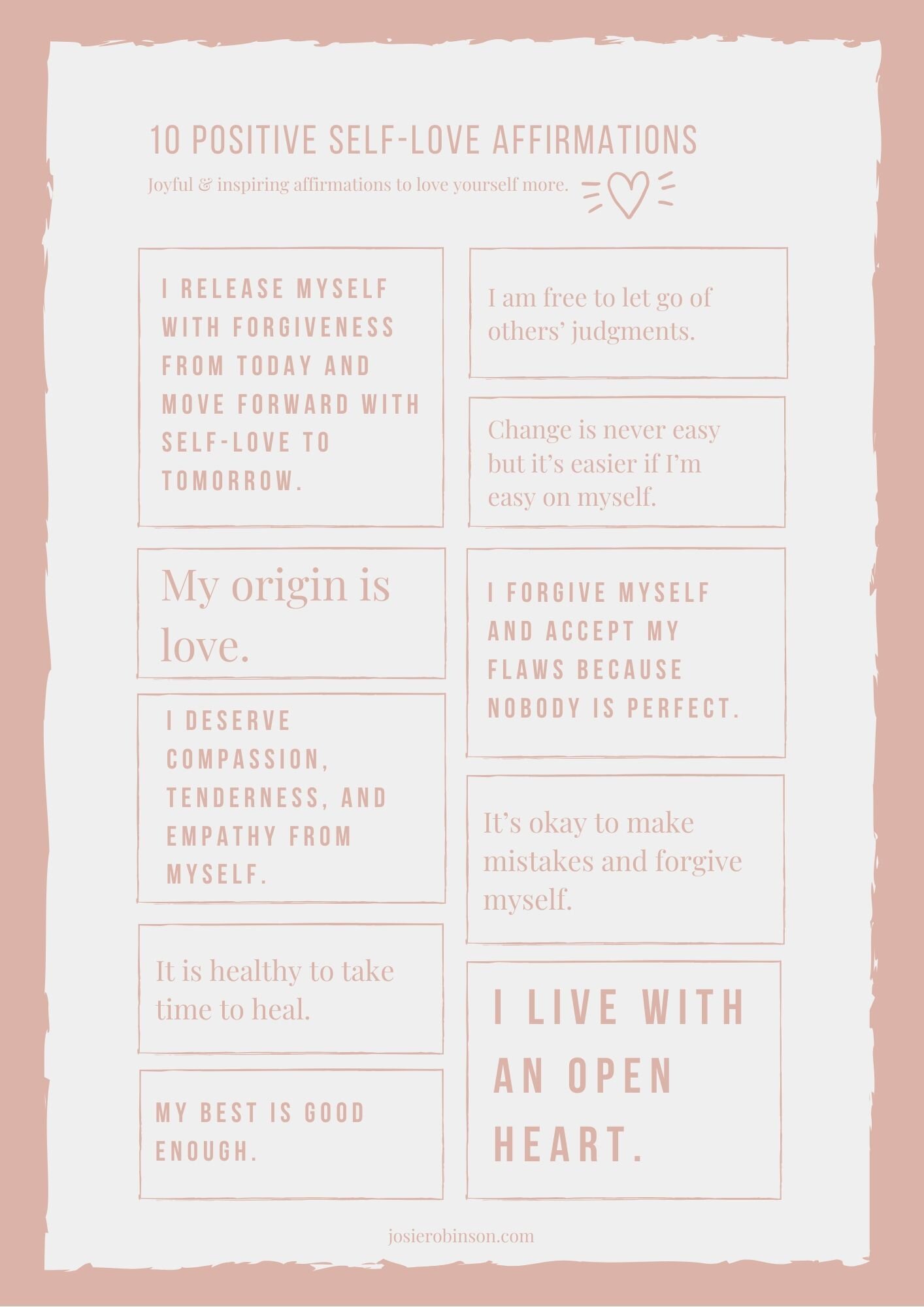Unleash the Power of Self-Compassion: 5 Practices to Heal Your Life
“Rather than wandering around in problem-solving mode all day, thinking mainly of what you want to fix about yourself or your life, you can pause for a few moments throughout the day to marvel at what’s not broken. You.”
— Kristin Neff
I’ve always considered myself to be a compassionate person — following the Golden Rule as best I can by doing onto others as they would onto me, but lately I’ve realized that my compassion has never really included myself.
This is something I’m actively working to heal because when I’m just giving, giving, giving….I start feeling those familiar feelings of burnout coming on—like tiredness, crankiness, and wanting to hide out in a cave under a blanket.
When I’m in balance, receiving love as much as I’m giving, it I feels GOOD. Like, really great. Self love and compassion is so important!
The Beautiful Benefits of Self-Compassion
There’s also been a ton of scientific research demonstrating that practicing self-compassion:
Increases your motivation.
Boosts your happiness levels.
Improves how you feel about your body image.
Enhances your self-worth.
Fosters resilience and emotional balance.
Reduces mental health symptoms, including anxiety, depression, and stress.
So, if you’re one of those people who has an easier time taking care of everyone else but yourself and start feeling those familiar burnout feelings coming on—it’s time to start turning that love and care towards yourself.
Here are five of my favorite self-compassion practices that always fill my cup, and I hope they fill yours as well.
1) Read Books About Self-Compassion
Self-Compassion: The Proven Power of Being Kind to Yourself was the book that really started me on the path to becoming more kind and loving towards myself, and as dramatic this my sound…this book totally changed my life.
Self-Compassion by Kristen Neff on Amazon
Kristin Neff is an Associate Professor at the University of Texas in Austin. She has spent over a decade studying the effects of self-compassion, and has found remarkable things when people become more compassionate towards themselves.
Each chapter of the book includes information and research findings, Neff’s personal experience, and a few self-compassion exercises you can use.
I found the book to be super helpful and enlightening, and it really sparked me to start practicing self-compassion daily.
I’m also working through Kirstin’s companion workbook right now, The Mindful Self-Compassion Workbook: A Proven Way to Accept Yourself, Build Inner Strength and I’ve found it to be an excellent companion to her book.
The Mindful Self-Compassion Workbook is based on Kristin’s groundbreaking eight-week Mindful Self-Compassion (MSC) program, which has helped tens of thousands of people all over the world.
There are beautiful guided meditations, simple and informal practices, and inspiring stories of people using the techniques to address relationship stress, weight and body image issues, health concerns, anxiety, and other common problems.
If you’re just starting your self-compassion journey or looking to deepen your practice, I highly recommend reading both these books!
2. Start a Self-Compassion Journal
Writing has always been a deeply therapeutic activity for me, and if you feel the same I think you’ll find great value in this next exercise.
This beautiful self compassion journal activity is from Kristin Neff’s website where she shares several free self-love and self-compassion exercises like this one, which is my personal favorite:
Simply get a pen and some paper and complete the following 3 steps:
Part One: Which imperfections make you feel inadequate?
Everybody has something about themselves that they don’t like; something that causes them to feel shame, to feel insecure, or not “good enough.” It is the human condition to be imperfect, and feelings of failure and inadequacy are part of the experience of living a human life. Try writing about an issue you have that tends to make you feel inadequate or bad about yourself (physical appearance, work or relationship issues…) What emotions come up for you when you think about this aspect of yourself? Try to just feel your emotions exactly as they are – no more, no less – and then write about them.
Part Two: Write a letter to yourself from the perspective of an unconditionally loving imaginary friend
Now think about an imaginary friend who is unconditionally loving, accepting, kind and compassionate. Imagine that this friend can see all your strengths and all your weaknesses, including the aspect of yourself you have just been writing about. Reflect upon what this friend feels towards you, and how you are loved and accepted exactly as you are, with all your very human imperfections. This friend recognizes the limits of human nature, and is kind and forgiving towards you. In his/her great wisdom this friend understands your life history and the millions of things that have happened in your life to create you as you are in this moment. Your particular inadequacy is connected to so many things you didn’t necessarily choose: your genes, your family history, life circumstances – things that were outside of your control.
Write a letter to yourself from the perspective of this imaginary friend – focusing on the perceived inadequacy you tend to judge yourself for. What would this friend say to you about your “flaw” from the perspective of unlimited compassion? How would this friend convey the deep compassion he/she feels for you, especially for the pain you feel when you judge yourself so harshly? What would this friend write in order to remind you that you are only human, that all people have both strengths and weaknesses? And if you think this friend would suggest possible changes you should make, how would these suggestions embody feelings of unconditional understanding and compassion? As you write to yourself from the perspective of this imaginary friend, try to infuse your letter with a strong sense of his/her acceptance, kindness, caring, and desire for your health and happiness.
Part Three: Feel the compassion as it soothes and comforts you
After writing the letter, put it down for a little while. Then come back and read it again, really letting the words sink in. Feel the compassion as it pours into you, soothing and comforting you like a cool breeze on a hot day. Love, connection and acceptance are your birthright. To claim them you need only look within yourself.
3) Practice Unconditional Forgiveness
I heard about Ho'oponopono from a friend who said she’d been using it daily to help her find peace in the midst of a difficult situation.
The literal translation of Ho'oponopono is: “to put to right; to put in order or shape, correct, revise, adjust, amend, regulate, arrange, rectify, tidy up, make orderly or neat.”
In a nutshell, it means putting yourself back together, lovingly, through forgiving yourself.
I love Ho'oponopono because it is extremely simple to do. All it requires is for you to repeat the following mantra throughout the day whenever a challenging feeling or situation arises:
“I love you. I’m sorry. Please forgive me. I’m sorry.
— Ho'oponopono Mantra
The premise of Ho'oponopono is that we are 100% responsible for everything that comes into our life, and the best way to heal whatever might be showing up is by loving and forgiving it so we can live in total gratitude in the present moment.
I’ve been repeating the Ho'oponopono mantra throughout the day whenever a difficult emotion or situation arises and have found it instantly calms me down.
It’s so easy to spiral into anxiety when something challenging enters our awareness, but this simple mantra helps stop anxious thoughts in their tracks and not take us over.
4. Use Supportive Touch
This is another beautiful exercise from Kristen Neff’s website and so simple to do.
Supportive Touch Exercise by Kristen Neff:
Touch activates the care system and the parasympathetic nervous system to help us calm down and feel safe. It may feel awkward or embarrassing at first, but your body doesn’t know that. It just responds to the physical gesture of warmth and care, just as a baby responds to being cuddled in its mother’s arms. Our skin is an incredibly sensitive organ. Research indicates that physical touch releases oxytocin, provides a sense of security, soothes distressing emotions, and calms cardiovascular stress. So why not try it?
You might like to try putting your hand on your body during difficult periods several times a day for a period of at least a week.
Hand-on-Heart
When you notice you’re under stress, take 2-3 deep, satisfying breaths.
Gently place your hand over your heart, feeling the gentle pressure and warmth of your hand. If you wish, place both hands on your chest, noticing the difference between one and two hands.
Feel the touch of you hand on your chest. If you wish, you could make small circles with your hand on your chest.
Feel the natural rising and falling of your chest as you breathe in and as you breathe out.
Linger with the feeling for as long as you like.
Some people feel uneasy putting a hand over the heart. Feel free to explore where on your body a gentle touch is actually soothing. Some other possibilities are:
One hand on your cheek
Cradling your face in your hands
Gently stroking your arms
Crossing your arms and giving a gentle squeeze
Gently rubbing your chest, or using circular movements
Hand on your abdomen
One hand on your abdomen and one over heart
Cupping one hand in the other in your lap
5. Say Self Love Affirmations
We can’t change our tendencies to blame, criticize, or put ourselves down unless we try to catch ourselves in the act, and reframe them. One of the best ways to do this is through positive and loving affirmations.
So, the next time you find yourself having one of those negative automatic thoughts, replace it with a self-love affirmation instead.
Here are 11 beautiful examples, with a free printable PDF you can use to print each affirmation out and carry them with you throughout your day:
11 Positive Self Love Affirmations
It’s okay to make mistakes and forgive myself.
I am free to let go of others’ judgments.
It is healthy to take time to heal.
I deserve compassion, tenderness, and empathy from myself.
I release myself with forgiveness from today and move forward with self-love to tomorrow.
I forgive myself and accept my flaws because nobody is perfect.
My best is good enough.
I live with an open heart.
Change is never easy but it’s easier if I’m easy on myself.
My origin is love.


